2009 OPEL ZAFIRA change wheel
[x] Cancel search: change wheelPage 94 of 228
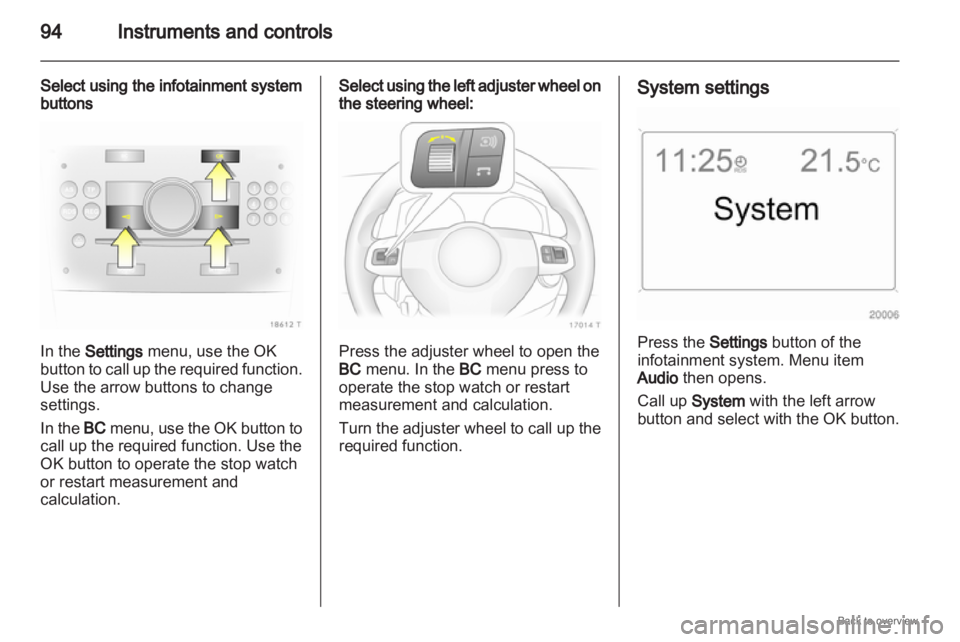
94
Instruments and controls
Select using the infotainment system
buttons In the Settings menu, use the OK
button to call up the required function.
Use the arrow buttons to change
settings.
In the BC menu, use the OK button to
call up the required function. Use the
OK button to operate the stop watch
or restart measurement and
calculation. Select using the left adjuster wheel on
the steering wheel:
Press the adjuster wheel to open the
BC menu. In the BC menu press to
operate the stop watch or restart
measurement and calculation.
Turn
the adjuster wheel to call up the
required function. System settings
Press the Settings button of the
infotainment system. Menu item
Audio then opens.
Call up
System with the left arrow
button
and select with the OK button.
Page 111 of 228
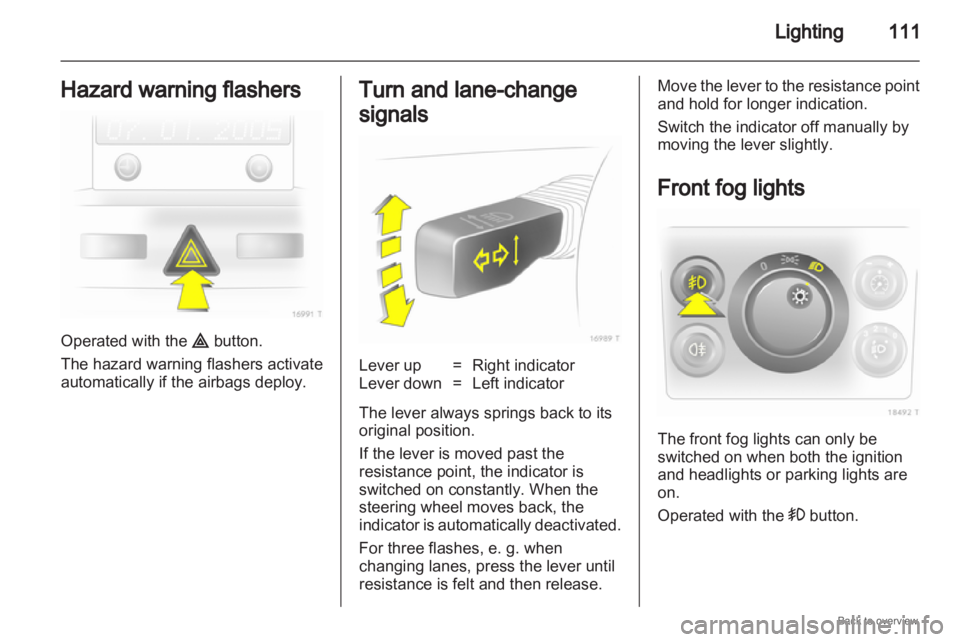
Lighting
111
Hazard warning flashers Operated with the ¨ button.
The hazard warning flashers activate
automatically if the airbags deploy. Turn and lane-change
signals
Lever up = Right indicator
Lever down = Left indicator
The lever always springs back to its
original position.
If the lever is moved past the
resistance point, the indicator is
switched on constantly. When the
steering wheel moves back, the
indicator
is automatically deactivated.
For three flashes, e. g. when
changing lanes, press the lever until
resistance is felt and then release. Move the lever to the resistance point
and hold for longer indication.
Switch the indicator off manually by
moving the lever slightly.
Front fog lights
The front fog lights can only be
switched on when both the ignition
and headlights or parking lights are
on.
Operated with the > button.
Page 124 of 228
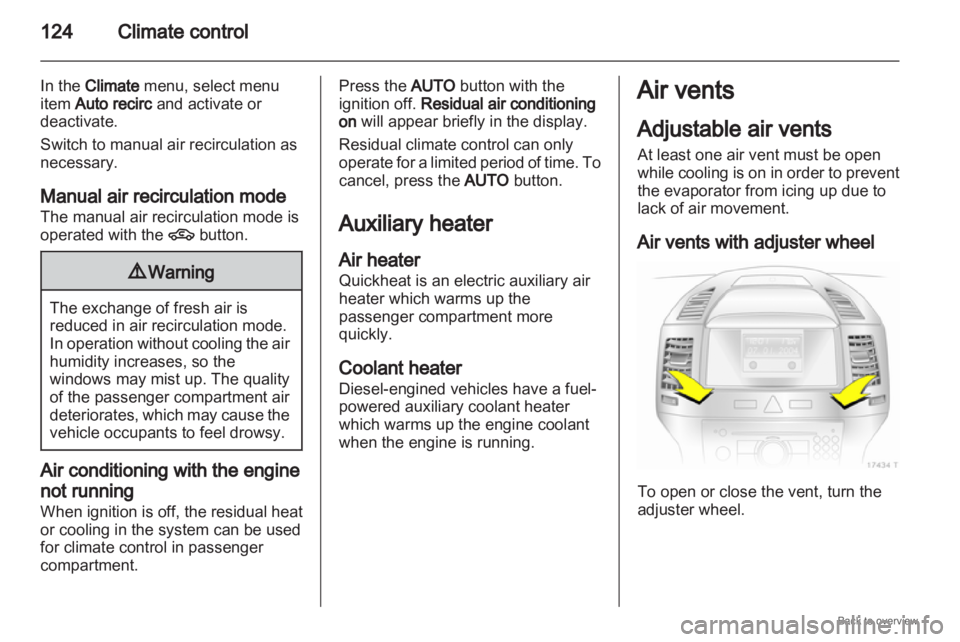
124
Climate control
In the Climate menu, select menu
item Auto recirc and activate or
deactivate.
Switch to manual air recirculation as
necessary.
Manual air recirculation mode
The manual air recirculation mode is
operated with the 4 button. 9
Warning The exchange of fresh air is
reduced in air recirculation mode.
In
operation without cooling the air
humidity increases, so the
windows may mist up. The quality
of the passenger compartment air
deteriorates, which may cause the
vehicle occupants to feel drowsy. Air conditioning with the engine
not running
When
ignition is off, the residual heat
or cooling in the system can be used
for climate control in passenger
compartment. Press the AUTO button with the
ignition off. Residual air conditioning
on will appear briefly in the display.
Residual climate control can only
operate
for a limited period of time. To
cancel, press the AUTO button.
Auxiliary heater
Air heater
Quickheat is an electric auxiliary air
heater which warms up the
passenger compartment more
quickly.
Coolant heater
Diesel-engined vehicles have a fuel-
powered auxiliary coolant heater
which warms up the engine coolant
when the engine is running. Air vents
Adjustable air vents
At least one air vent must be open
while
cooling is on in order to prevent
the evaporator from icing up due to
lack of air movement.
Air vents with adjuster wheel To open or close the vent, turn the
adjuster wheel.
Page 154 of 228

154
Vehicle care
Vehicle care
General Information ...................154
Vehicle checks ........................... 155
Bulb replacement .......................160
Electrical system ........................167
Vehicle tools .............................. 173
Wheels and tyres .......................174
Jump starting ............................. 185
Towing ....................................... 187
Appearance care .......................189 General Information
Accessories and vehicle
modifications
We
recommend to use Genuine Parts
and Accessories and factory
approved parts specific for your
vehicle type. We cannot assess or
guarantee for other products - even if
they have a regulatory or otherwise
granted approval.
Do not make any modifications to the
electrical system, e. g. changes of
electronic control units (chip tuning).
Vehicle storage
Storage for a long period of time
Following must be done if the vehicle
should be stored for several months:
■ Wash and wax the vehicle.
■ Have the wax in the engine compartment and underbody
checked.
■ Clean and preserve rubber seals.
■ Change engine oil. ■ Drain washer fluid reservoir.
■
Check coolant anti-freeze andcorrosion protection.
■ Adjust tyre pressure to the value specified for full load.
■ Park vehicle in dry, well ventilated place. Engage first or reverse gear
or set selector lever to P. Prevent
the vehicle from rolling.
■ Do not apply hand brake.
■ Open bonnet, close all doors and lock the vehicle.
■ Disconnect the clamp from the negative terminal of the vehicle
battery. Beware that all systems are
not functional, e.g. anti-theft alarm
system.
Putting back into operation
Following must be done if the vehicle
is putting back into operation: ■ Connect the clamp to the negative terminal of the vehicle battery.
Activate the electronic of the power
windows.
■ Check tyre pressure.
■ Fill up the washer fluid reservoir.
Page 175 of 228
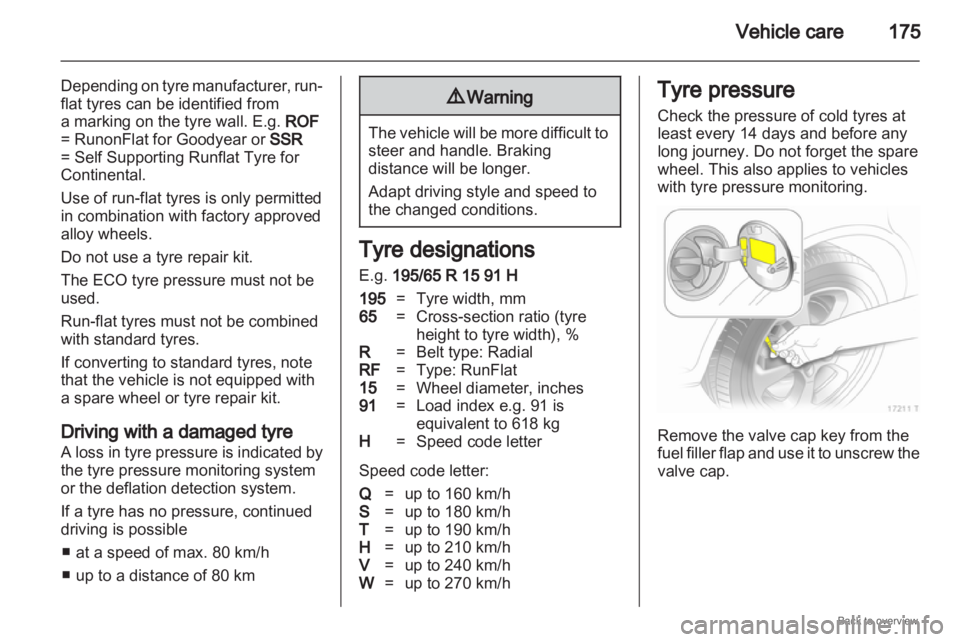
Vehicle care
175
Depending on tyre manufacturer, run-
flat tyres can be identified from
a marking on the tyre wall. E.g. ROF
= RunonFlat for Goodyear or SSR
= Self Supporting Runflat Tyre for
Continental.
Use of run-flat tyres is only permitted
in combination with factory approved
alloy wheels.
Do not use a tyre repair kit.
The ECO tyre pressure must not be
used.
Run-flat tyres must not be combined
with standard tyres.
If converting to standard tyres, note
that the vehicle is not equipped with
a spare wheel or tyre repair kit.
Driving with a damaged tyre
A
loss in tyre pressure is indicated by
the tyre pressure monitoring system
or the deflation detection system.
If a tyre has no pressure, continued
driving is possible
■ at a speed of max. 80 km/h
■ up to a distance of 80 km 9
Warning The vehicle will be more difficult to
steer and handle. Braking
distance will be longer.
Adapt driving style and speed to
the changed conditions.
Tyre designations
E.g. 195/65 R 15 91 H
195
=Tyre width, mm
65 =Cross-section ratio (tyre
height to tyre width), %
R = Belt type: Radial
RF =Type: RunFlat
15 =Wheel diameter, inches
91 =Load index e.g. 91 is
equivalent to 618 kg
H = Speed code letter
Speed code letter:
Q = up to 160 km/h
S = up to 180 km/h
T = up to 190 km/h
H = up to 210 km/h
V = up to 240 km/h
W = up to 270 km/h Tyre pressure
Check the pressure of cold tyres at
least every 14 days and before any
long journey. Do not forget the spare
wheel. This also applies to vehicles
with tyre pressure monitoring.
Remove the valve cap key from the
fuel
filler flap and use it to unscrew the
valve cap.
Page 177 of 228
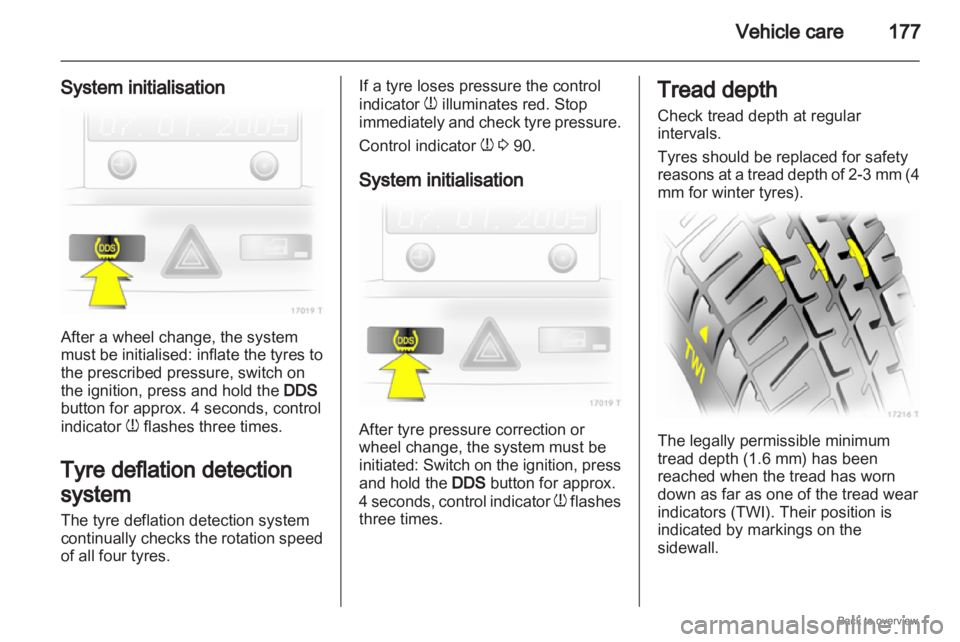
Vehicle care
177
System initialisation After a wheel change, the system
must
be initialised: inflate the tyres to
the prescribed pressure, switch on
the ignition, press and hold the DDS
button for approx. 4 seconds, control
indicator w flashes three times.
Tyre deflation detection
system
The tyre deflation detection system
continually checks the rotation speed
of all four tyres. If a tyre loses pressure the control
indicator
w illuminates red. Stop
immediately
and check tyre pressure.
Control indicator w 3 90.
System initialisation After tyre pressure correction or
wheel change, the system must be
initiated:
Switch on the ignition, press
and hold the DDS button for approx.
4 seconds, control indicator w flashes
three times. Tread depth
Check tread depth at regular
intervals.
Tyres should be replaced for safety
reasons
at a tread depth of 2-3 mm (4
mm for winter tyres). The legally permissible minimum
tread depth (1.6 mm) has been
reached when the tread has worn
down as far as one of the tread wear
indicators (TWI). Their position is
indicated by markings on the
sidewall.
Page 182 of 228
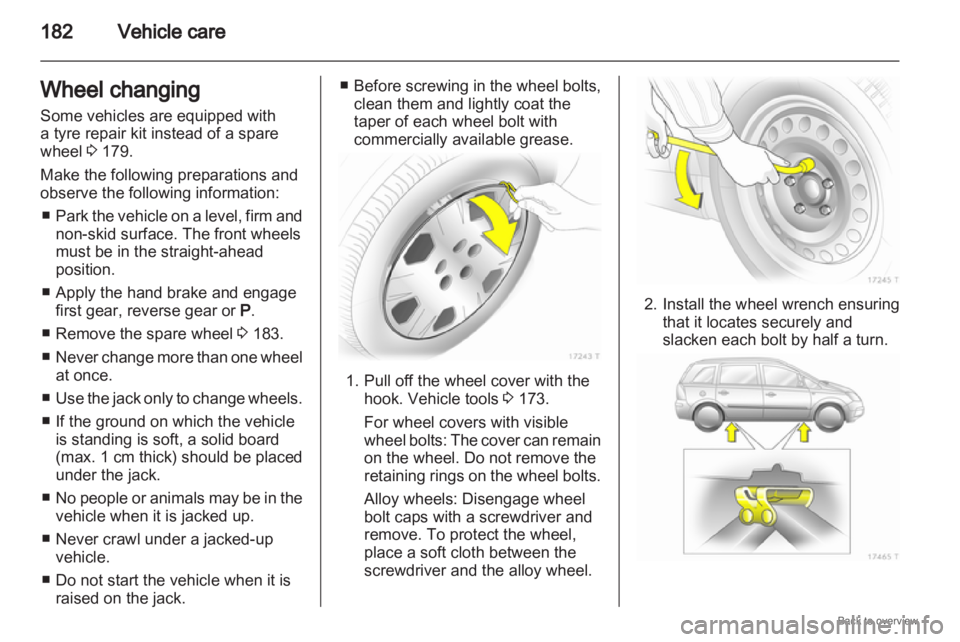
182
Vehicle care
Wheel changing
Some vehicles are equipped with
a tyre repair kit instead of a spare
wheel 3 179.
Make the following preparations and
observe the following information: ■ Park
the vehicle on a level, firm and
non-skid surface. The front wheels
must be in the straight-ahead
position.
■ Apply the hand brake and engage first gear, reverse gear or P.
■ Remove the spare wheel 3 183.
■ Never change more than one wheel at once.
■ Use the jack only to change wheels.
■ If the ground on which the vehicle is standing is soft, a solid board
(max. 1 cm thick) should be placed
under the jack.
■ No people or animals may be in the vehicle when it is jacked up.
■ Never crawl under a jacked-up vehicle.
■ Do not start the vehicle when it is raised on the jack. ■ Before screwing in the wheel bolts,
clean them and lightly coat the
taper of each wheel bolt with
commercially available grease. 1. Pull off the wheel cover with the
hook. Vehicle tools 3 173.
For wheel covers with visible
wheel
bolts: The cover can remain
on the wheel. Do not remove the
retaining rings on the wheel bolts.
Alloy wheels: Disengage wheel
bolt caps with a screwdriver and
remove. To protect the wheel,
place a soft cloth between the
screwdriver and the alloy wheel. 2. Install the wheel wrench ensuring
that it locates securely and
slacken each bolt by half a turn.
Page 183 of 228

Vehicle care
183
3. Ensure the jack is positioned correctly with the vehicle jacking
points. 4. Set the jack to the necessary
height before positioning it directly
below the jacking point in
a manner that prevents it from
slipping. Attach jack handle and with the
jack correctly aligned rotate
handle until wheel is clear of the
ground.
5.
Unscrew the wheel bolts.
6. Change the wheel.
7. Screw in the wheel bolts.
8. Lower vehicle.
9. Install the wheel wrench ensuring that it locates securely and tighten
each bolt in a crosswise
sequence. Tightening torque is
110 Nm.
10. Align the valve hole in the wheel cover with the tyre valve before
installing. Install wheel bolt caps.
11.
Stow the replaced wheel 3 179
and the vehicle tools 3 173.
12. Check the tyre pressure of the installed tyre and also the wheel
bolt torque as soon as possible.
Have the defective tyre renewed or
repaired.
Spare wheel
The spare wheel can be classified as
a temporary spare wheel depending
on the size compared to the other
mounted wheels and country
regulations.
The spare wheel has a steel rim.
Use of a spare wheel that is smaller
than the other wheels or together with
winter tyres could affect driveability.
Have the defective tyre replaced as
soon as possible.